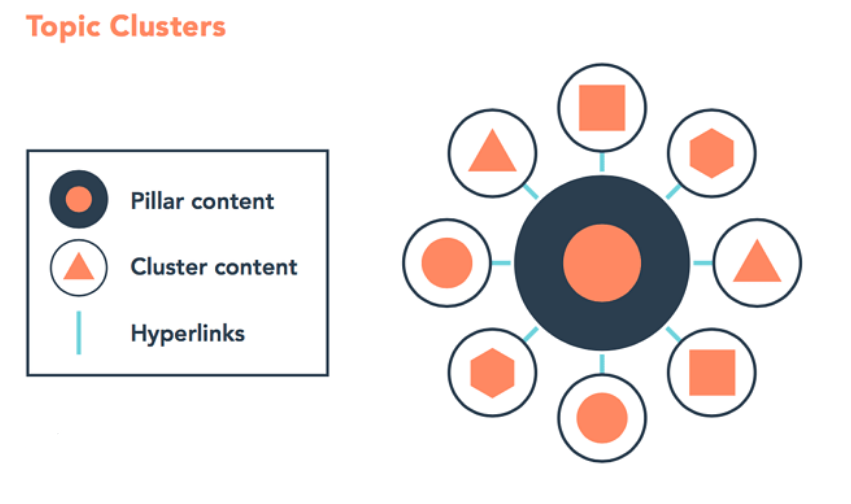Topic Clusters for SEO: How to Create & Analyze Them?
Posted By Gaurav | 26-Sep-2023 |
Content structure and organization matter a lot when it comes to growing your website content in the right manner. One of the biggest mistakes that most website owners make is to not focus on the proper interlinking or organization of content available on their website. It creates confusion for the readers as well as the search engines. Unorganized content doesn’t only ruin the user’s experience, it also makes it difficult for the search engines to index the content.
This is where topic clusters come as a great solution. By adding topic clusters to your website, you can make the search engines believe that you are an expert in a particular subject. By covering a topic thoroughly, you can establish your website’s authority over it. Let us help you understand what topic clusters are and how you can create them.
What are Topic Clusters?
Topic clusters are the groups of website pages that are aimed at establishing the website’s authority over a particular subject. These are used to improve the performance of website pages, especially through search engines. There is a pillar page that gives a broad idea about the main subject and multiple cluster pages that cover relevant subtopics in detail. The pillar page is linked to all the cluster pages and vice versa.
Topic clusters are crucial for making your website authoritative in the eyes of search engines. The more quality content you publish on a relevant topic, the more keywords you can rank for and the more authority you gain over a particular topic. This is important because Google aims to rank E-E-A-T websites, i.e. the websites that demonstrate Experience, Expertise, Authoritativeness, and Trustworthiness.
Creating Topic Clusters
Here are the steps to create topic clusters that can boost engagement on your website and help you drive more organic traffic:
1. Choose The Core Topic
Your first step while creating a topic cluster should be to choose the main topic around which you want to create multiple clusters. You can start with a simple brainstorming session where you ask yourself a few essential questions. Try to figure out what topics are relevant to your brand, what has worked for you in the past, what topics your target audience really wants to read about, etc.
The topic you choose should be wide enough to cover several subtopics. However, make sure that it is not too broad that your cluster topics become oversized. Keeping all these things in mind, you can decide on the right core topic for creating a topic cluster.
2. Find Relevant Keywords for The Pillar Page
After deciding on the core topic, you can start your research for relevant keywords. Look for the keyword clusters that best represent your main topic or the target keywords that you want to rank for. This is a crucial step to follow as it helps you find the best cluster topic ideas and create SEO-friendly content that ranks higher. You can find and collect relevant keywords using different keyword research tools available online these days.
Instead of targeting just one keyword, the idea here is to target a set of keywords or one keyword cluster to a particular page. When you optimize your content like this, it helps you rank for various keywords instead of just one. You must look at the following metrics while doing keyword research for the pillar page:
-
Volume: This is the average number of monthly searches for a particular keyword. Search volume helps you define the potential reach of your pillar page, i.e. how many people your page can reach every month.
-
Intent: This refers to the different types of keywords in a particular cluster. Generally, topic clusters are built around two types of keywords, including the ones with informational search intent and those with commercial search intent.
-
KD%: Here, KD refers to the ‘Keyword Difficulty’ score. The higher the score, the more difficult it is to rank on top searches.
3. Find Keywords for Cluster Pages
After finding keywords for the main/pillar page, you need to find the relevant keywords that can be used as related subtopics. You don’t need to perform keyword research separately for the cluster pages. The research you have performed for the pillar page would work for these pages as well. The primary keywords of your cluster pages should be used as the secondary keywords on the pillar page. Make sure that you use keywords carefully while keeping in mind that the keywords don’t look forced into the content.
4. Write Good Quality Content
No matter how many relevant keywords you incorporate into your page, it is not going to rank high until you focus on the quality of content you create. Instead of just focusing on the keywords, try to make your content as helpful and relevant as possible. Start with the pillar page that provides a broad idea of what your core topic is all about. After writing the content for the pillar page, you get a foundation for the cluster pages and start writing for them.
While writing content for the pillar page, keep in mind that you need to link it to the cluster pages. Once you write and publish the pillar page, you can start working on the cluster pages at your own pace. However, it is better to publish and interlink them without unnecessary delay. The sooner you publish the pages, the sooner you can see the results.
With the recent September 2023 Helpful Content Update, Google has clearly stated that it will give better visibility to pages with ‘people-first’ content, i.e. content that is aimed at helping the readers rather than just being SEO-friendly content. So, make sure that you keep the interests and requirements of your audience in mind while creating content for pillar and cluster pages.
Analyzing Topic Clusters
After you have created topic clusters, it is time to measure and analyze them. You can use various tools and metrics to measure the performance of your topic clusters. Monitor the organic search traffic your pillar page generates, check for the rankings of your keywords, track the CTR (Click Through Rate) of internal links, and see how your clusters are performing. Topic Clusters are an effective SEO strategy that can help you take your website to another level if you use them wisely.
Also read:-

